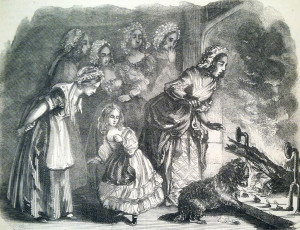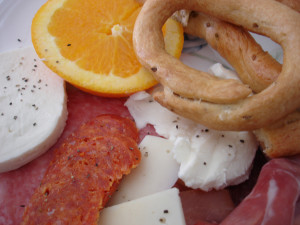I’ll let you in on a little secret: I consider it is a small cause for celebration every time someone subscribes to the Convivio Book of Days blog. And so I tend to take it a little personally when someone unsubscribes. It doesn’t happen very often, but nonetheless, after a steady increase in readership over the course of the six months that the blog’s been running, we began losing subscribers this past month. We lost a bunch of people, all at Eastertime. Some left without saying why, but two explained: The writing had become “too religious” for them.
Of course if they had stuck around a few days longer, they would have found three spells straight out of witchcraft practices in the chapter on St. Mark’s Eve, and now we come to Walpurgis Night and May Day, two holidays that the Church really despised back in the old days for what they called “heathenness.” Let’s set the record straight right here: the Book of Days covers all kinds of holidays, and many of them come out of religious observances of one kind or another. The very word holiday is derived from holy day. So if you’re going to go along for this ride with me through the seasons of the natural year, you’re going to have to be careful not to get your knickers in a bunch just because something reminds you of the nuns at your parochial school. The Book of Days does not profess a particular system of belief. That doesn’t matter to me. What matters to me is the immersion in ceremony, and I believe we can dabble in ceremonies that are cross cultural and rich in tradition no matter what our personal beliefs.
And so let’s look at these two holidays so unwelcome by the Church. For most of the Northern Hemisphere, May brings that welcome shift from winter to summer, and these next two days are set aside to welcome summer in. Oddly enough, they don’t get much notice here in the United States. Perhaps the Puritans, who were so good at putting the brakes on mirth and joy, did a number on us. During their time in power in England, the Puritans put an end to both Christmas and May Day celebrations. Maypoles in villages throughout England were removed. But it’s hard to keep joy smothered. Once the Puritans were out of the picture, the people began returning maypoles and May Day customs to the village greens, and with good reason: May Day celebrates the return of summer with all its warmth and openness. It is the luminous time of year. Think about the long winter we’ve just experienced in this country: you’d think folks would be ready to jump up and celebrate the arrival of summer with some real festivity and some real gusto, but these two days will be ordinary days for most Americans. We’re just not that into Walpurgis Night and May Day.
And of course the Church was opposed to May Day celebrations: the celebrations could be pretty scandalous. Folks would head out into the woods and fields from May Eve (Walpurgis Night) and not come back home again until the next day. Who knows what they were doing out there. The customs of May Day come out of ancient fertility rituals, and so folks were most likely doing just what the Church feared they were. And why shouldn’t they? The rivers are a’runnin’ and the earth is being warmed by the growing sun. People would go out into the woods on Walpurgis Night and return on the morning of May Day with flowers in their hair and grass stains on their clothes and most likely a small uptick in births nine months later.
Walpurgis Night is big in Scandinavia, especially Sweden and Finland, as well as in Germany. It is a holiday mostly of northern and central Europe, although even in Italy there is celebration on the Eve of May. There, it’s known as Calendimaggio, and the maypoles, they say, are festooned with prosciutto, mortadella, cheeses, and money. Talk about festive!
In England, it’s not so much the eve as the morning that’s important for May Day, and the custom is to rise before dawn and head out to the fields to “bring in the may,” returning home with bundles of flowers that are then used to decorate the doorways, the hearth, the windows, everything. There are traditional dances around the maypole in the village green, and traditional carols of the season: For summer is a comin’ in and winter’s gone away-o! are words you’ll hear often in various traditional songs for May Day.
And summer is a comin’ in. Even here in Lake Worth, this land of perpetual green, the landscape erupts into bloom in May. The most notable blooms are that of the Royal Poinciana trees that will start blooming toward the end of the month, bright red, a sure harbinger of summer. And while we may not follow many of these customs here in the States, there’s nothing that says you can’t have your own little celebration even if no one else is doing much to mark the occasion. For Walpurgis Night, which comes with the setting sun on April 30, it is customary to light a bonfire and to eat gravlax, which is a type of smoked fish, washed down with quantities of sparkling wine. Easy enough to do. You may not have a place to light a big bonfire, but if you have a fire pit outside in your yard, why not go ahead and light a little fire, or at least a candle? And while you’re sitting around the fire, you may as well break open a bottle of sparkling wine. I’ll be stopping to visit my friends at Neptune Fish Market on Dixie Highway on my way home from work to pick up some of their own wonderful local smoked fish, and that’ll serve well for the gravlax. So there you have it: a very easy (and very reverent) celebration for Walpurgis Night.
The bonfires of Walpurgis Night are the same fires that the Celts built to welcome Beltane, the summer season, which begins on this night, too, as the Celtic calendar switches from winter to summer. This is the counterpart to Samhain, which welcomed winter on the last night of October. We enter now the sweeter time of year, warmer, easier. Our viewpoint shifts outward: we have emerged out of the darkness and into the light. The earth is exploding with new growth. The loving cup is overflowing.
Today’s images are from the May Day celebrations of our friend Pixie Mayhem. The photographs come courtesy of book artist Mare Blocker, who knows Pixie better than anyone in this world.



